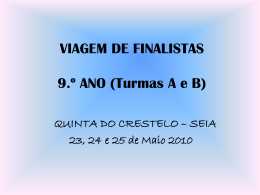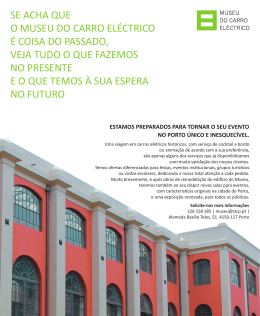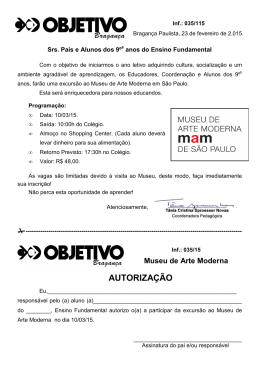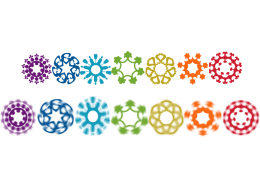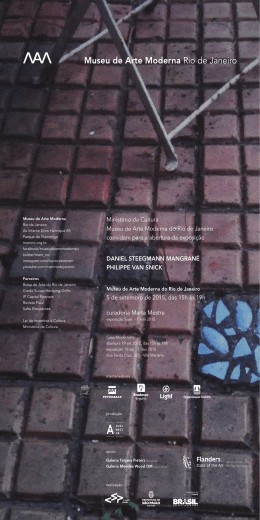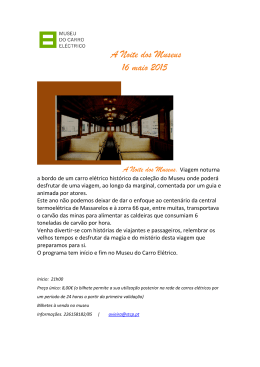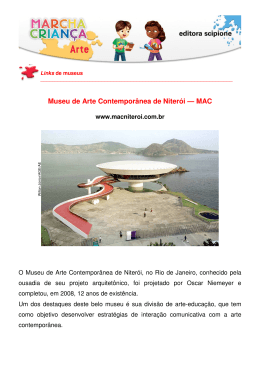MNAA Olhares Contemporâneos Contemporary Visions 19.05 – 30.09.2012 Jardim Garden MNAA Museu Nacional de Arte Antiga fazenda/valladares António Câmara Manuel Maria José Peyroteo Textos Texts António Filipe Pimentel José Manuel Santos Maria do Mar Fazenda Filipa Valladares Tradução Translation Vivóeusébio Impressão Printing Instituto Nacional – Casa da Moeda IN-CM Duarte Azinheira Gonçalo Ferreira de Almeida Jean François Chougnet Mariana Castelo Branco Carla Manso C O lh on ar te es m C po on ra te ry m V po is io râ ns João Paulo Serafim João Serra Patrícia Almeida David - Alexandre Guéniot Ramiro Guerreiro EDP João Pinharanda José Manuel dos Santos CML José Sá Fernandes Catarina Vaz Pinto Isabel Rodrigues Paulo Braga Manuela Azevedo Miguel Caissotti A A João Ferro Martins João André Abreu Design A A Catarina Botelho ão osiç Exp io à Apo Produção Production N N ég ico Curadoria Curators M es tra t E: [email protected] M Me ce na sd a Re sid ên cia Rua das Janelas Verdes 1249-017 Lisboa T: + 351 21 391 2800 F: + 351 21 397 3703 MNAA António Filipe Pimentel José Alberto Seabra Carvalho Anísio Franco Joaquim Oliveira Caetano Teresa Pacheco Pereira Conceição Borges Alexandra Markl Rui Trindade Luís Montalvão Celina Bastos Susana Campos Teresa Serra e Moura Paula Brito Ramiro Gonçalves Hugo Ribeiro Emília Marcos Vasco Senhora Julieta Senhora Fátima Senhor Carlos Herminda Lopes Inspector José Teixeira Dulce Gonzaga Inês Ferreira Paulo Moutinho João Figueiras José Ribeiro Rogério Roxo Rúben Rodrigues Orlando de Almeida Liliana Araújo Catarina Bastos Sandra Vieira Carlos Gonçalves André Afonso Pa rc eir o Terça-feira das 14h00 às 17h30 Quarta-feira a Domingo das 10h00 às 17h30 Tuesdays from 14h00 to 17h30 Wednesdays through Sundays from 10h00 to 17h30 Entrada Livre Admission Free Agradecimentos Acknowledgements Sandra Rocha Pro duç ão o E DP no y nc e d n id A es M N A Fu R ia P e nc ED t t h ê d o i a ã s aç Re d n Fu ã aç A MN Pr r og A am ne os Um museu não é em primeiro lugar o seu acervo, o património que materializam as suas coleções. Um museu é, ex aequo, este e o diuturno trabalho que convoca: preservando, estudando, ampliando, comunicando, recriando. Em perpétua extração de informações novas ou novas narrativas. Memória e ato simultaneamente. O acervo e a casa que enche (e habitam os que a habitam). É, na religião patrimonial que professamos, o hoje que fazemos, incontornavelmente. Contemporaneamente, pois: com os olhos postos a um tempo em passado e futuro. Donde a convocação oportuna desta plêiade de olhares por detrás de câmaras. De olhares subjetivos, caleidoscópicos. Descomprometidos. Deslumbradamente virgens na sua aproximação iniciática. Fixando no instante (de cada um deles) o eterno e o fugaz de que o Museu se faz, no dia a dia em que se tece a conquista do futuro para a qual labuta: em permanente luta contra o tempo, esse voraz destruidor; em permanente construção do tempo, que não existe sem matéria nem memória(s). Nesse arco temporal nunca fechado, apenas o olhar do fotógrafo logra capturar o instante que é ele. Ao património de que o Museu é feito, faltava acrescentar este valor. A museum is not first and foremost its collections. A museum is, in equal amounts, the estate and the incessant work it summons: to preserve, study, enhance and recreate, in a constant and perpetual extraction of new information and new narratives. It is concurrent memory and action; the assets and the home it fulfills (and those who inhabit it); it is, in the patrimonial religion we profess, the today we indisputably create. Thus, contemporary: with our eye set on a past and future time. Hence the timely gathering of this pleiad of eyes behind the cameras. Subjective, kaleidoscopic views. Uncompromised views. Bewildered and pure in their initiatic approach. Capturing in the moment (each their own) both the eternal and the fleeting the Museum is made of, in the daily woven quest for the future it is invested in. In permanent struggle with time, the voracious annihilator. In permanent rendering of time, which cannot exist without matter or recollection(s). In that neverending temporal arc, only the photographer triumphs in rendering the instant. To the estate that composes the Museum, this was an asset that remained to be added. Estas fotografias são o outro espaço do espaço do Museu e o outro tempo do seu tempo. Olhamos um no outro, olhamos um pelo outro. Há muitos anos, uma criança entra pela primeira vez no Museu de Arte Antiga e olha. A professora fala, mas a criança ouve-a pouco, porque quer ver muito. Vê não apenas o que vê, mas também o futuro desse ver. Se há encontros, aquele dia foi deles. Sempre que, mais tarde, lembrei essa visita, lembrei também a aparição de tudo, o zoom do olhar, a obsessão da memória. Nessa manhã, a criança olhou como se fotografasse. Esse dia veio até mim quando levaram à Fundação EDP este projecto: “MNAA Olhares Contemporâneos – Residência Fundação EDP no Museu Nacional de Arte Antiga” . A ideia de António Filipe Pimentel foi a de dar aos fotógrafos a vez da sua vez: entrem no Museu e, dele, levem lá para fora o que quiserem. Entendamo-nos: dele, levem as imagens que escolherem. Assim se fez. Olhamos agora o resultado e sabemos que sim. A Fundação EDP olha-se nestes “Olhares” e reafirma que gosta muito de participar, com o MNAA, as curadoras, os artistas, o produtor, o público, neste projecto. A todos, saúda. E lembra o que um dia disse André Malraux: “A cultura não se herda, conquista-se”. These photographs are the Museum’s other space and other time. We can see one in the other, and one through the other. Many years ago, a child walked into the Museu de Arte Antiga for the first time and looked around. The teacher is speaking, but the child hears little of what she is saying, because he wants to see everything. He sees not only what he sees, but also the future of that glance.If there are such things as findings, that was their day. Everytime that, later on, I recalled that visit, I also recalled the revealing of all those things, the proximity of the stare, the obsession of memory. That morning, the child looked as if he was photographing. That day was brought to my memory when the EDP Foundation was presented the “MNAA Contemporary Visions - EDP Foundation residency program at the Museu Nacional de Arte Antiga” project. Antonio Filipe Pimentel’s idea was to provide the photographers their own turn of walking into the museum and bringing out whatever they eye fancied. Let us be clear: bring out whichever images their eyes fancied. And so it was. We are now presented with the result, and we know they did. At the EDP Foundation, we can see ourselves in these “Visions” and we restate our pleasure in participating in this project, along with the MNAA, the curators, the artists, the producer and the public. We salute them all. And we bring back the words once spoken by André Malraux: “Culture is not inherited, but conquered.” António Filipe Pimentel José Manuel dos Santos Diretor do Director of Museu Nacional de Arte Antiga Diretor Cultural da Fundação EDP Cultural Director for the EDP Foundation MNAA Olhares Contemporâneos Contemporary Visions A exposição “MNAA Olhares Contemporâneos” tem como ponto de partida a ideia de António Filipe Pimentel de apresentar uma exposição de fotografia no jardim do museu. Os trabalhos agora apresentados são o resultado da Residência Fundação EDP no Museu Nacional de Arte Antiga. Dando continuidade à abertura do museu a olhares contemporâneos, procurou-se não repetir formatos experimentados anteriormente, nos quais as obras dos artistas dialogavam com uma peça específica, com uma determinada época ou com o próprio contexto museológico. A proposta de uma residência artística no museu acrescentou a estes motivos, a possibilidade de os artistas trabalharem a vida própria do museu, descobrirem as suas áreas menos visíveis, contactarem intimamente com o património que ali é guardado e de os integrar no seu olhar, pensamento e prática artística. Com este propósito, convidou-se Catarina Botelho, João Ferro Martins, João Paulo Serafim, João Serra, Patrícia Almeida + David-Alexandre Guéniot, Ramiro Guerreiro e Sandra Rocha, para conviverem, durante uma semana, juntamente com as curadoras, os conservadores e técnicos, no museu à Rua das Janelas Verdes. A troca foi recíproca. E as respostas a este diálogo são agora devolvidas, em imagens apresentadas em MUPIs que pontuam o Jardim. No exterior, mas ainda dentro do museu, estas obras participam da paisagem e tempos diversos de que o museu é testemunha viva. The MNAA Contemporary Visions exhibition was based upon António FIlipe Pimentel’s idea of setting up a photography exhibition for the museum’s garden. The works now presented are the result of the EDP Foundation residency program at the Museu Nacional de Arte Antiga. In the spirit of the museum’s receptivity to contemporary points of view, the attempt was not to repeat previously used formats, in which the artists’ work was based on a specific piece, a certain period or on the museological context itself. The project of an artistic residency at the museum adds to these themes the possibility of having the artists work within the museum’s own routine , discovering its least accessible areas, and in close contact with its contents, providing them with opportunity to include these aspects in their artistic views, thoughts and practices. In this context, Catarina Botelho, João Ferro Martins, João Paulo Serafim, João Serra, Patrícia Almeida + David-Alexandre Guéniot, Ramiro Guerreiro and Sandra Rocha were invited to work for a week, along with the curators and technical staff, in the museum.. The dialogue between all was fruitful. And the result is now delivered, in the form of images, displayed in MUPI outdoor light boxes that punctuate the garden. Outdoors, yet still within the museum, these works participate in the landscape and in the diversity of ages of which the museum is a living witness. fazenda / valladares Curadoria Curatorship Catarina Botelho Catarina Botelho tem vindo a desenvolver uma linguagem visual, que tem dado especial destaque à análise da Natureza Morta. O conteúdo das suas obras, embora organizado segundo estruturas ou cânones clássicos, concentra-se sobre o esquecido, o abandonado, o que fica à margem do olhar. Durante a residência, CB centrou-se nos espaços em transição e nos espaços em espera. Nestas zonas cinzentas do museu, nas quais não há presença humana nem obras expostas, iluminadas ou descobertas, o seu olhar foi direccionado para os elementos que indiciam o que ficou da relação sensível de um corpo. Neste sentido, estas imagens, próximas de um género tão profusamente representado no museu, protagonizam interpretações da Natureza Morta contemporânea. Catarina Botelho has developed a visual language that devotes particular emphasis to the study of the Still Life. The content of her work, though structured in accordance with classical canons, focuses on the forgotten, the deserted, that which is left aside by our look. During the residency, CB devoted her attention to transitional and waiting areas. In these grey areas of the museum, where no human presence can be found, and no pieces are displayed, illuminated or uncovered, her eye was drawn towards the elements that indicate traces of human presence. In that sense, these images, akin to a genre so profusely represented in the museum, provide a contemporary interpretation of the Still Life. João Ferro Martins João Ferro Martins desenvolve uma prática artística multidisciplinar que potencia os seus meios e formatos de acção. São vários os momentos em que provoca um diálogo entre a música e a arte visual e por vezes, esta dinâmica, é traduzida por um acto performativo, em nome individual assim como em equipes autorais. Avançamos com a ideia de que é esta faceta do trabalho de JFM, que implica um contacto frequente e directo com o público, que direccionou o seu olhar para os espaços de acesso generalizado: as salas de exposição das colecções representadas no MNAA. Estas salas são povoadas por objectos falantes. Estes objectos falam de nós, são testemunhos de uma história e constroem um discurso sempre em reformulação. A interferência com estes objectos, neste espaço, recupera este discurso e reanima o nosso olhar. João Ferro Martins engages in pluridisciplinar artistic practices that enhance his range and field of expression. He frequently establishes a dialogue between music and visual arts, and this dynamic sometimes results in performance, both individually and as part of creative collectives. We suggest that it was this side of JFM’s work - that implies frequent and direct contact with the public - that drove his attention towards the public access areas: The museum’s display rooms. These rooms are populated by speaking objects. Such objects speak of us, they are witnesses to history and generate an ever changing discourse. Interfering with these objects, within this location, retrieves that discourse and revives our look. João Paulo Serafim João Paulo Serafim continua o seu trabalho de questionamento da imagem e do seu lugar dentro do processo museológico. Na residência, JPS estudou os primeiros catálogos editados pelo museu e interessouse, particularmente, pela descrição textual das obras, que substituíam a reprodução de imagens. A legendagem exaustiva das obras nestas edições, ganham um papel equivalente ao da imagem, dando ao leitor a informação que na altura se considerava relevante para descrever uma obra e criando uma narrativa que recriava a obra. JPS encena o que nos é dado a ver em dois tempos distintos: assume o próprio texto como imagem e como pré-visualização da imagem para questionar a forma como lemos/ vemos. Este jogo de leituras, entre imagem e texto, surge assim como parte essencial da construção da memória destas imagens. Colocando no museu, local privilegiado de preservação da memória, a sua re-invenção. João Paulo Serafim continues his work in questioning the use of image and its place within the museological process. During the residency, JPS studied the very first catalogues published by the museum, and was particularly interested in the written descriptions of the works featured in the catalogues, which replaced any visual reproductions. The thorough description of the works featured in these publications attains a role of equal significance to that of the image, providing the reader with all the information pertinent for the mental recreation of the piece described. JPS questions the way we read an image, leading us through two distinct stages of that reading: The text is presented first, both as an image itself and as a mental pre-visualization tool for a piece, after which we are shown the image of the piece itself. This play on perception between image and text emerges as essential to the construction of the memory of these images. João Serra João Serra segue o (não)método próprio do flâneur. É na deambulação, na procura descomprometida que encontra o objecto do seu olhar. JS tem circunscrito o seu mapeamento, sobretudo, nas realidades urbanas periféricas, onde a paisagem arquitectónica se desenvolve de modo orgânico. Também característico do olhar apaixonado do flâneur é o encontro do extraordinário no quotidiano vulgar. A designação da sua fotografia como documental, quando regista uma determinada vivência que lembra a cena do “Repouso na Fuga para o Egipto”, não será a mais assertiva. Assim como, no registo quase cientifico do reverso de uma pintura do séc. XV-XVI, lemos antes a imagem de uma pintura abstracta. Numa assumida relação de dualidade entre as duas imagens apresentadas no MUPI, um verso e uma frente são definidos. No nosso movimento entre eles, na sua leitura, debatemo-nos com diversos tempos e ideias e suas representações. João Serra follows the typical (non)method of the flâneur. It is when wondering, in an uncompromised quest, that he finds the object of his attention. JS has devoted his mapping mostly to peripheral urban environments, where the architectural landscape develops organically. Also characteristic of the flâneur’s passionate view is finding the extraordinary in the most banal quotidian. Classifying his photography as documental, when he records a specific reality that reminds us of the scene in “Rest on the flight into Egypt”, is probably not the most assertive choice. Neither when, in the near-scientific photograph of the back of a 15th or 16th century canvas, we perceive an abstract painting. In an assumed duality between the two images displayed in the MUPI lightbox, a front and a verse are defined. In our movement between them, in our reading, we are faced with different times and ideas, and their representations. Patrícia Almeida David-Alexandre Guéniot Patrícia Almeida e David Alexandre Guéniot têm vindo a trabalhar a fotografia documental em sentido lato. Nesta residência optaram por retratar aqueles que dentro da instituição acompanham e guardam as obras diariamente perante o olhar e as acções dos visitantes - os vigilantes do museu. Neste processo foi-lhes pedido que recriassem as suas posições de vigilância, mas curiosamente tanto as posturas dos corpos como as expressões de concentração nos rostos, sugerem semelhanças com as poses que identificamos na história do retrato clássico, na pintura como na fotografia. Ao deslocar a atenção das obras para os vigilantes, os artistas invertem o seu papel na instituição. Por momentos, retira da penumbra estas pessoas, dá-lhes um rosto visível e transforma-as, temporariamente, no objecto do nosso olhar (substituindo o das obras a vigiar). Patrícia Almeida e David Alexandre Guéniot have been exploring photography- along the lines of the documental record - as a field for artistic creation. During this residency they chose to portray those within the institution whose daily function is to guard the works in display: The museum guards. During the process they were asked to reenact their everyday working stances. Curiously, their postures and focused facial expressions suggest stances found in classical portraiture - both in painting and photography. By shifting the focus from the works in display to the museum guards, the artists reverse the role of the latter within the institution. For a moment, these individuals are removed from obscurity, given a visible face and become the object of our attention. ated compositions that express the various forms of thinking the museological space. His approach focused on two moments in MNAA history: The renovation of the museum in the context of the ‘83 exhibition, and the now extinct Gulbenkian Room, where Calouste Gubenkian’s donations to the Museum were once displayed. Both these transformations altered the museum’s own discourse. Ramiro Guerreiro Sandra Rocha Ramiro Guerreiro iniciou a sua formação em arquitectura. A relação com o espaço arquitectónico é uma abordagem recorrente na sua pesquisa artística. Durante a residência, RG deu especial atenção ao material relativo à construção do Anexo e outras remodelações arquitectónicas, assim como se interessou pelos projectos dos dispositivos de apresentação das obras (armários, vitrinas, exposições). A sua prática prende-se com uma ideia de documento e das valências que lhe são intrínsecas: a imagem (enquanto testemunho) e a narrativa (como forma de história). A partir da recolha de documentos de arquivos, criou composições que dão expressão às várias formas de pensar o espaço museológico. A sua abordagem focou dois momentos na história do MNAA: a renovação do museu no âmbito da exposição de ‘83 e a invocação da extinta Sala Gulbenkian, onde eram expostas as obras doadas por Calouste Gulbenkian ao Museu. Transformações que alteraram o discurso do museu sobre si mesmo. Ramiro Guerreiro originally trained as an architect. The relationship with the architectonic space is a recurring approach in his artistic research. During the residency, RG devoted particular attention to the materials related to the construction of the Annex and other architectural renovations. He was also interested in projects regarding the museum’s display devices (cabinets, display windows, exhibitions). His practises are closely linked to the concept of document and its intrinsic qualities: image (as a testimony) and narrative (as form of History). Following his research in the museum’s archive, he cre- Sandra Rocha cruza no seu trabalho a tradição do olhar documental com uma leitura poética dos lugares da sua deambulação pessoal. No decorrer da residência SR escolheu trabalhar o espaço da Capela das Albertas, única área que se manteve do extinguido Convento de Carmelitas que veio dar lugar ao edifício Anexo ao Palácio dos Condes Alvor, as duas partes que compõem o MNAA. Atraída pela fragilidade do património e pelo simbolismo que o espaço encerra, apropriou-se de dois elementos na capela. A ilusão óptica, própria da arquitectura barroca, assiste uma representação daquilo que era o mundo exterior e é uma imagem da cissão daquela ordem religiosa com a vida. Apresentadas como frente e um verso, temos duas versões de uma mesma porta que se espelham, num diálogo entre o que se fecha no seu interior e o que tal como num museu se abre para o mundo. Sandra Rocha combines in her work the tradition of the documental point of view and a poetical perspective on locations. During the residency, SR chose to work within St.Albert’s Chapel, the only remaining area of the now extinct Carmelitas Convent that, along with the Alvor Palace, constitutes the premises presently occupied by the MNAA. Drawn by the chapel’s frailty and symbolism, she appropriated two of its elements. The optical illusion, characteristic of baroque architecture, represents the interdiction to the outside world , and depicts the religious order’s separation from the profane. Presented as front and verse, two versions of the same door, in a dialogue between what is kept inside and what is, as in a museum, open to the world. 1 2 3 4 ·3 ·2 ·4 ·6 ·5 ·1 ·7 1 4 Catarina Botelho João Serra *Modo de emprego #1 *User’s manual #1 Sem Título Untitled Modo de emprego #2 User’s manual #2 *Repouso na Fuga para o Egipto *The Rest on the Flight to Egypt 2 Patrícia Almeida David-Alexandre Guéniot A partir de Porto de Mar, 1740 d.C. –1775 d.C. de Claude Joseph Vernet, Lisboa 2012 After Seaport, 1740 a.C.–1775 a.C. by Claude Joseph Vernet, Lisbon 2012 *Os Vigilantes *The Museum Guards 5 João Ferro Martins *A partir de Bothisava (Matreia em meditação), Sec. VII, Período Asuka (Japão) ou Reino de Paekche (Coreia), Lisboa 2012 *After Bodhisattva (Maitreya in meditation), 7th Century, Asuka Period (Japan) or Paekche Kingdom (Korea), Lisbon 2012 3 5 6 7 6 Ramiro Guerreiro A nova entrada The new entrance *Dispositivos de apresentação *Display devices 7 João Paulo Serafim Sandra Rocha A Invenção da Memória – MNAA 003 The Invention of Memory – MNAA 003 Porta, Capela das Albertas Door, St Albert Chapel A Invenção da Memória – MNAA 004 The Invention of Memory – MNAA 004 *Trompe-l’oeil,Capela das Albertas *Trompe-l’oeil, St Albert Chapel Imagens produzidas no contexto da Residência Fundação EDP, que ocorreu em Março de 2012. Fotografias impressas com tinta UV sobre papel city-light 150g, na L2Spirit – ART DIVISION sob a coordenação de António Bettencourt) e apresentadas na exposição “MNAA Olhares Contemporâneos” em MUPIs instalados no jardim do Museu Nacional de Arte Antiga. Images produced for the MNAA Contemporary Visions exhibition, during the EDP Foundation Residency program that took place in March 2012. The photographs were printed at L2Spirit – ART DIVISION , under the supervision of António Bettencourt, using UV ink on city-light 150g paper, and displayed on MUPI outdoor lightbox displays installed in the garden of the Museu Nacional de Arte Antiga. * Fotografias reproduzidas neste desdobrável. Fotografias reproduzidas neste desdobrável.
Download
